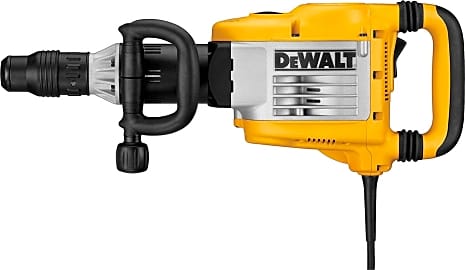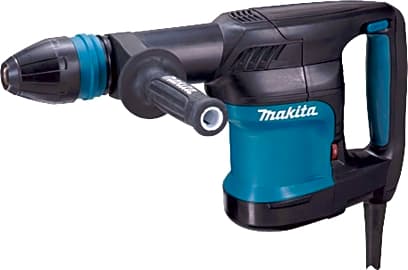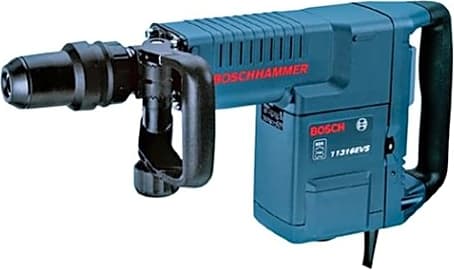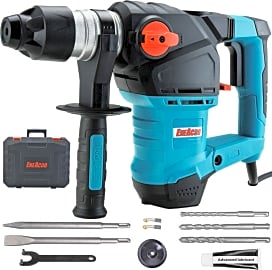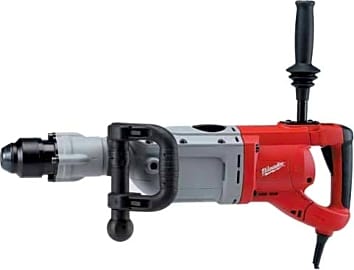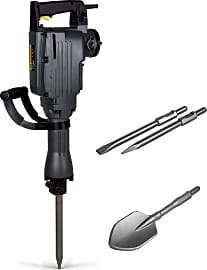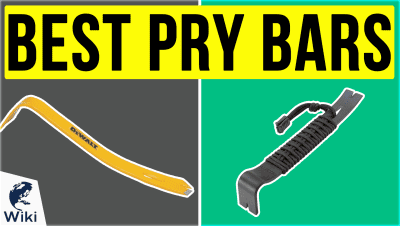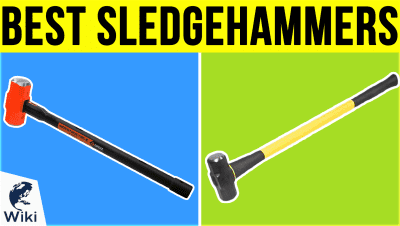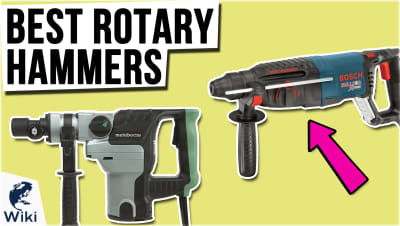The 10 Best Demolition Hammers

This wiki has been updated 40 times since it was first published in June of 2015. Need more power for your next renovation job? One of these demolition hammers will blast through unwanted driveways and walls or rip out old tile to clear a path for new construction. They can even take care of tree roots and break up boulders too large to move. Our selection includes everything from industrial-strength models to smaller and lighter options well suited to home DIY work. When users buy our independently chosen editorial picks, we may earn commissions to help fund the Wiki.
Editor's Notes
November 02, 2020:
We removed the Neiko 02845A because of some longevity issues, and replaced it with the Eneacro SDS-Plus. This lightweight model is perfect for demolition jobs that require you to be mobile, and maneuver around a lot, like taking down a cinderblock wall or brick structure. Its 360-degree handle makes it even more convenient to use, and the rubber handles make for a nice comfortable grip. In addition to the standard chisel bit, the Eneacro SDS-Plus also includes several drilling bits, which can be just as effective at demolishing masonry, or prepping for a sledgehammer.
Using a demolition hammer will likely create a large amount of dust and concrete debris. These particles can be extremely harmful, so a dedicated dust mask or respirator should always be worn while operating. Eye protection should also be worn at all times.
If you’ve never used a demolition hammer before, it might surprise you how hot the bits and accessories can get. Remember to always wear gloves when removing bits, and take care not to toss them into your tool bag or anywhere else where they might melt or damage delicate equipment.
If your demolition job requires something a bit more low-tech, a sledgehammer might be a better option. If you’re also dealing with a lot of lumber or house framing as well, a good solid pry bar will be a lot more helpful than a typical carpenters hammer.
June 02, 2019:
Demolition work is all about matching the tool to the job. If you try and use an underpowered hammer to break through large amounts of an extremely hard material, not only will it take a very long time, but you risk overheating or otherwise damaging the tool. On the other hand, if you bring a huge 70-pound jackhammer to bear on a small bathroom tile job where an 11-pound model would suffice, you will unnecessarily wear yourself out, not to mention risk losing control of the large tool and hitting and destroying something you meant to preserve, like that bathroom cabinet you weren't planning on replacing. If you run a company that regularly handles large demolition jobs, then you will be best served with a model built to withstand long periods of use and with a lot of power, such as the DeWalt D25980KB, Makita HM1810X3, and Makita HM1317CB. Homeowners who have a large job, but aren't in a hurry to get it down, or need to break up some small areas of very hard material, like dense stone or extremely hardened concrete, can go with a lesser-quality, but still powerful model, like the XtremepowerUS X1108, Neiko 02845A, and TR Industrial TR89100. These affordable unints probably won't last through years of use, but can easily handle some big home jobs and don't cost a ton of money. The Milwaukee 5339-21 is a commercial-grade unit that straddles the middle ground of large units that are very unwieldy and smaller units that can't handle large jobs, making it a smart choice for homeowners who feel they may put a demolition hammer to use often on a wide range of jobs. The DeWalt D25901K SDS Max, Makita HM0870C, Bosch 11316EVS are all well-suited to precision work in small areas. They have minimal kickback and will allow you to avoid fixtures that are too time-consuming or difficult to remove for a limited amount of demo work. The DeWalt D25901K SDS Max, Milwaukee 5339-21, and Makita HM1317CB deserve special mention for having user-adjustable speed control.
Demolition Done Properly
You will see demolition hammers at work in the hands of home builders, road crews, plumbers, and many other professional workers.
Before a renovation or construction project can commence, there's often the grueling but important work of demolition to be done. Unless the project at hand calls for a 100% tear down that can be completed with bulldozers and excavators, most demolition work comes down to the efforts of individual workmen. Using the right tools for the job can not only make the work of demolition go faster, but can help ensure that it's an effective and safe process, too. Improper demolition can not only damage the wrong parts of a building or home, driving up costs, but can also present serious safety hazards, compromising structural integrity and causing serious injury to the workers.
Sledgehammers and saws are effective tools for many types demolition of, and large jackhammers can be effective for many aspects of a demo project as well. But the single most effective tool in the arsenal of a construction team charged with breaking apart existing construction is the demolition hammer. Few tools combine both accuracy and brute strength so ably as this versatile tool.
Before we talk about choosing the right demolition hammer for your needs, let's discuss why this tool is generally well-suited to myriad applications.
Demolition hammers concentrate the immense force to a precise area, usually a pointed tip or flat chisel-shaped plane. Properly guided against an appropriate surface, a demo hammer's bit can make short work of brick, concrete, asphalt, stone, and many other durable materials and surfaces. More precise than a sledgehammer (and easier to use, as well), a demolition hammer can be used as part of a total tear down of a structure or to create only a small hole in a wall or ground covering surface, perfect for servicing pipes or wiring without an unnecessarily large amount of destruction. So it might seem ironic to say, but using a demolition hammer can actually prevent unnecessary demolition.
You will see demolition hammers at work in the hands of home builders, road crews, plumbers, and many other professional workers. They are also a handy tool for the DIY enthusiast who wants to maximize the efficient use of his or her time; while certainly more expansive than a simple sledgehammer, a demolition hammer makes short work of big jobs.
Choosing The Right Demolition Hammer
The standard demolition hammer you'll find in most homes or in the hands of a worker renovating a residence or smaller commercial facility is also known as a rotary hammer as its chisel is driven forward and backward by in internally rotating mechanism. The plug-in demolition hammer's proper name is electro-pneumatic hammer, though this term is less frequently used.
The plug-in demolition hammer's proper name is electro-pneumatic hammer, though this term is less frequently used.
Choosing the right demolition hammer to suit your needs comes down to the scale of the work to be done. As logic would suggest, the larger the demolition hammer, the more destructive force it can deliver. These tools range in weight from only a dozen pounds to many dozens of pounds, but bigger is not always better. If you are breaking down walls, for example, a large, heavy rotary hammer may be too unwieldy for accurate horizontal use, while a smaller hammer may allow for precision that more than compensates for its lower per-thrust force. Smaller demo hammers also reduce operator fatigue (as do features like vibration controls) that allow for longer use.
On the other hand, if you're primarily breaking up concrete floors, brick walkways or patios, or asphalt driveways, then by all means opt for a larger, heavier demolition hammer. In these cases, their weight only increases their efficacy thanks to gravity.
Also consider the bits (frequently called chisels) that will best suit the type of work you most often undertake; while most demolition hammers can handle most standard bits, if you use unusually large, narrow, or otherwise specialized bits, not all demo hammers may be suitable for your needs.
Demolition Hammer Use And Maintenance
As with any power tool, safety and caution are of extreme importance when using a demolition hammer. An operator should wear thick gloves, protective goggles, and reliable ear protection; demolition hammers can cause severe hearing damage with prolonged exposure. Also aways be sure the area in which the tool will be used can handle the vibrations associated with its use, as a demolition hammer can inadvertently damage surfaces without even touching them. Be particularly cautious using a demolition hammer around tile, stone, and other rigid materials.
A point tip can break through concrete walls or help break apart joints or light welds.
Also consider wearing sturdy boots in case you drop the hammer and/or for protection from falling materials.
Demolition hammers can accommodate multiple different types of bit, and each bit serves a different purpose. For example, the flat spade bit is great for breaking through the seams between bricks or pavers. A point tip can break through concrete walls or help break apart joints or light welds. A stake driver is a wider bit that can be used to drive posts or rebar into position.
Choosing the right size of hammer and the right chisel for the job at hand can help you avoid collateral damage and will save you time and effort as you complete any and all needed demolition.





